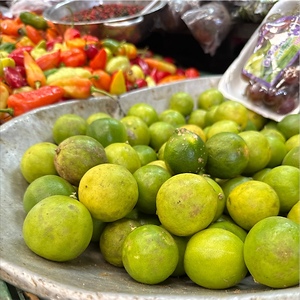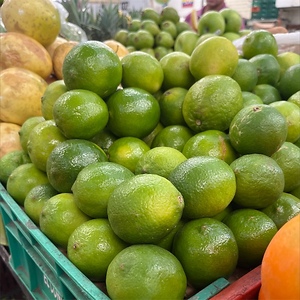


Pajarito Limes
Estimated Inventory, lb : 0
Description/Taste
Pajarito limes are small in size, averaging 3 to 6 centimeters in diameter, and have a round to oval shape with blunt, curved edges, sometimes tapering to a small nipple at the tip of the fruit. The limes are generally 45 to 55 grams in weight, and the rind is thin with a slight give. The rind also ripens from green to yellow-green hues and is glossy, textured, and leathery. When scratched, the surface releases aromatic essential oils, giving the rind an oily feel. The rind may also have a few brown markings, but these spots are only superficial and do not affect the overall quality of the flesh. Underneath the rind, the pale yellow-green flesh is divided into 10 to 12 segments by thin, barely noticeable membranes. The flesh is comprised of tiny pulp vesicles that create a fine, smooth, juicy, and plump consistency. The flesh also contains a few to many oval, cream-colored seeds. Pajarito limes are known for their bright, zesty scent and have an acidic, subtly sweet, tangy, sour, and tart flavor with floral, citrusy undertones.
Seasons/Availability
Pajarito limes are available year-round.
Current Facts
Pajarito limes, botanically classified as Citrus aurantifolia, are a small varietal belonging to the Rutaceae family. The name Pajarito is a moniker commonly used throughout Colombia, roughly translating to mean “little bird." The species is also called Limón Pajarito, Limón Criollo, and Common lime in Colombian markets. It is important to note that limón is used for both lemons and limes in Colombia, sometimes leading to some confusion between various species. Outside of Colombia, Pajarito limes are generally called Mexican and West Indian limes. Pajarito limes grow on small, evergreen trees reaching 1 to 4 meters in height and form individually or in clusters on the branching tips. The small fruits have been widely cultivated in Colombia for centuries and are often considered a common type of lime sold in commercial markets. Pajarito limes are favored for their robust aroma and juice, notably incorporated into beverages and sweet or savory culinary dishes in Colombia.
Nutritional Value
Pajarito limes are a source of vitamins A, C, E, and K. Vitamin A maintains the health of organs, while vitamin C strengthens the immune system. Vitamin E guards the cells against the damage caused by free radicals, and vitamin K assists the body in producing proteins that help the blood form clots for wound healing. Pajarito limes also provide fiber to regulate the digestive tract, calcium to support bones and teeth, potassium to balance fluid levels and replenish electrolytes, iron to develop the protein hemoglobin for oxygen transport through the bloodstream, and other nutrients, including niacin, phosphorus, magnesium, zinc, riboflavin, and thiamine. The aromatic scent in the fruit’s peel indicates the presence of limonene, a liquid with a lemon-like odor. The peel also contains other essential oils used in natural medicines and homemade perfumes, cosmetics, and soaps. Pajarito limes are occasionally used in home remedies to fight against colds and flu, aid in digestion, or be topically applied to bug bites.
Applications
Pajarito limes have an acidic, bright, and zingy flavor suited for fresh or cooked preparations. The small limes are mainly used for their refreshing juice and are sliced and squeezed over dishes and drinks. Pajarito limes are juiced and mixed into various soft drinks, lemonades, cocktails, and juices. In Colombia, limonada de coco is a famous drink from the Caribbean region and is comprised of a limeade mixed with coconut. Pajarito limes can also be juiced into sauces, marinades, and dips such as guacamole or sprinkled over ceviche and other seafood dishes. The juice complements rich, savory flavors in rice dishes, fried fish, soups and stews, and salads. Pajarito limes can also be used to add a pop of flavor to ice cream, sorbets, sherbets, cakes, and other pastries. In addition to fresh uses, Pajarito limes are sometimes pickled whole or dried into pieces and zested into a powder for use as a spice. Pajarito limes pair well with herbs such as mint, oregano, coriander, and verbena, vegetables including potatoes, plantains, legumes, corn, and pumpkin, and meats such as beef, pork, and poultry. Whole, unwashed Pajarito limes will keep for several days to weeks when stored in the refrigerator. The limes can also be kept at room temperature for a few days, but it is recommended to immediately use the fruits after purchase to prevent them from drying out over time.
Ethnic/Cultural Info
Pajarito limes are traditionally used for their bright, refreshing, and acidic juice in Colombia and are notably served as a finishing element on bandeja paisa, the country’s national dish. Bandeja paisa is an emblematic dish that symbolizes Colombia’s hospitality and diversity. It is said the dish was created in the Antioquia region and was initially served to farmers as a hearty, filling meal to replenish energy. Bandeja paisa is customarily comprised of beans, rice, fried plantains, arepa, and a variety of meats, including blood sausage, chorizo, pork rinds, and eggs. The name “bandeja paisa” translates to “Paisa platter” as “bandeja” means “platter” or “tray,” and “paisa” is a reference to the region in Colombia. The meal is served on a tray or large plate and garnished with lime and avocado slices for enhanced flavoring. Bandeja paisa is also rooted in the blend of varying culinary practices. The dish incorporates local indigenous ingredients such as plantains and beans and mixes these with Spanish colonial introductions of sausages, beef, and pork. Over time, bandeja paisa was spread across the country, developing regional variations, and became a favored meal served on special occasions to honor Colombian heritage and promote community. In 2005, bandeja paisa was chosen by the Colombian government as the country’s national dish.
Geography/History
Citrus aurantifolia is native to Asia and is thought to have origins in tropical regions of Southeast and Southern Asia. The species has been growing wild since ancient times and eventually spread across Asia as it was chosen for natural breeding. Much of the species’ early history is unknown, but it is said that Arab traders may have been some of the first to encounter the species in Asia and transported the citrus to North Africa and the Middle East sometime during the 10th century. Citrus aurantifolia later expanded into Europe and was planted in Portugal and Spain around the 13th century. Spanish and Portuguese explorers carried Citrus aurantifolia to the Americas in the late 15th and early 16th centuries, and the species thrived in tropical regions, becoming naturalized. In Colombia, Citrus aurantifolia plants have been growing for so many centuries that they are often referred to as a native or common species. Today, varieties of Citrus aurantifolia, including Pajarito limes, primarily reside in tropical to warm, humid, subtropical climates. When in season, the fruits are harvested from wild and cultivated plants and are sold in fresh markets and through retailers in Colombia. Pajarito limes are primarily grown in the department of Nariño in Colombia and are also cultivated in the departments of Santander, Cauca, Tolima, Antioquia, and Risaralda. They are also exported to neighboring countries, including Venezuela and Ecuador.









